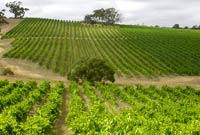
Although production is limited, the 2005 MAX V will be made available to all wine
enthusiasts and advocates of small batch winemaking in
early 2007. Please register
your interest by contacting info@rocwines.com.au
or visit our ORDERING PAGE
for further details.
Member's Login Page
Proceed to members section – with Behind the scenes, winemakers notes, barrel sample analysis, interviews
and a comprehensive photo gallery.
CABERNET SAUVIGNON COMPONENT
| Location | Western Valley of the Clare | |
| Sub Region | Sevenhill | |
| Variety | Cabernet Sauvignon | |
| Approx. Yield | 3 tonnes per acre | |
| Property Size | 8 acres of Cabernet Sauvignon - total property size: 113 acres of which 50 acres is under vine | |
| Age of Vines | The Cabernet Sauvignon vines were first planted in 1999 | |
| Soil type / Subsoils | Light sandy loam – over clay with darker soils at the bottom of the valley – limestone and sandstone. The clay coverage across the entire vineyards aids in the retention of moisture which helps feed the root system in dry periods. The limestone coverage aids helps excess water drainage in wet periods. | |
| Aspect | The Cabernet Sauvignon is planted in medium to heavier soils and receives more direct sunlight. In affect leading to a slow and long ripening period, as it is then cooled by the north to south St. Vincent gulf stream through the night. Statistically the prevailing winds off the Great Southern Ocean are at their strongest during the hotter month of January. The variation in slopes also allows for excellent drainage and an ideal environment to control vine vigour. |
VINEYARD MANAGEMENT
| Trellis System | (VSP) Vertical Shoot position with lifting wires 20 meters apart with steel in the middle | |
| Vine Spacing | Vines are 1.5-1.75 meters apart and 3 meter row spacing set up for mechanical harvesting | |
| Irrigation | 1 mega gallon per hectare is permitted through drip irrigation but rarely needed. Only in extreme hot years are vines kept from over stressing with minimal irrigation. | |
| Hand Pruning | The Cabernet Sauvignon is exposed to fruit-thinning and spur pruning in order to keep to a limited number of buds per vine to reduce yields, followed by machine harvesting, hand picking and hand sorting before crushing. An expensive but pivotal process in maintaining the highest quality. | |
| Grape Protection | The unique bowl shape of the Eldredge Vineyards allows for a constant cold airflow, which prevents any harm to the vineyards from frost. Substantial investment has also been made to netting the entire vineyard from birds, which have damaged vines in the past. |
GROWERS STATEMENT
Cabernet Sauvignon is well suited to both hot and cool climate regions, which are demonstrated through differing vintages in the Clare Valley. Uniquely the Clare Valley is statistically a warm to hot climate wine region, but the impact and influence of the St. Vincent gulf stream is expressed in the length and depth of the Cabernet’s produced on the Eldredge property. The lifted fruit flavour profile from soft black berry, cherry and black current and raspberry in the warmer vintages to the level of intensity shown through the minty, cedar, bell pepper and licorice flavours in cooler vintages. In addition the level of acidity in the Clare Valley is the basis for its balance and longevity as well as tannin structure across the palate.
KEY FRUIT CHARACTERISTICS – Cabernet Sauvignon
If not the king, as many argue, Cabernet Sauvignon is certainly the most successful and popular of the top-quality red wine grapes. It is the primary grape of most of the top vineyards in Bordeaux's Médoc and Graves districts. This reputation for excellence has launched a Cabernet Sauvignon popularity boom around the world. There's been heavy planting (which continues) in Chile, Australia, and Eastern Europe, especially Bulgaria. In addition, Cabernet Sauvignon has begun making inroads into areas of Spain and Italy where local grapes have dominated for centuries. In Bordeaux, Cabernet Sauvignon is most often blended with one or more of the following: merlot, cabernet franc, petit verdot, or malbec.

